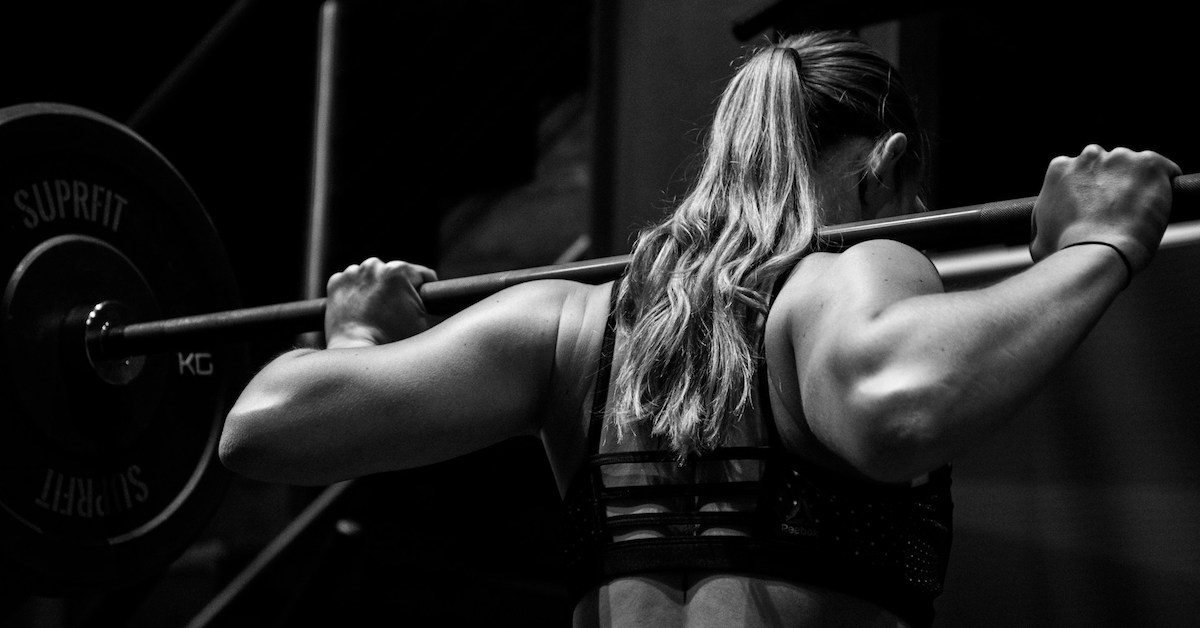Eccentric training will catapult strength and athletic performance to a new level if used appropriately. In order to lift a weight, muscular force must exceed the downward force of a load. The opposite occurs when you lower a weight – motor units are turned off until the downward force of the load is greater than the muscular force acting upon it. With fewer motor units active, greater tension and more damage occurs to the remaining muscle fibers, which prompts hypertrophy (LaStayo et al., 2003b; Ridgely, 2004).
One of the drawbacks of eccentric training deals with the extreme soreness that follows (Schwane et al., 1983; Zatsiorsky, 1995). A higher level of stress is imposed on the body and more time is required for recovery. In many cases, it takes as much as a week or more for full recovery from a bout of eccentric training (Fleck & Kraemer, 1987; Fridén et al., 1983). Therefore, an adequate base is necessary – at least two years of training experience is recommended before commencing pure eccentric work (Bompa, 1993; Poliquin, 1988).
Eccentric loading can be reduced and even eliminated with the use of elastic assistance (e.g., reverse-band setup), sleds, medicine balls, partner assistance, and in some cases by dropping the bar if using bumper plates. A useful method for beginners to avoid muscle soreness altogether involves introducing eccentrics in a progressive manner as demonstrated below.
Week 1 – 100% concentric, 0% eccentric
Week 2 – 100% concentric, 50% eccentric
Week 3 – 100% concentric, 100% eccentric (normal ratio)
For example, assume a beginner was to perform 2 sets of the seated cable pulldown exercise. During the first week, the trainee will pull the bar to their chest (the concentric action) while their partner returns the bar to the initial position (the eccentric action) for every repetition of both sets. During the second week, the trainee performs both the concentric and eccentric action for the first set only; the second set is conducted with partner assistance on the eccentric action. During the third week and on, the trainee now performs both the concentric and eccentric action for every repetition of both sets. Dr. Tudor Bompa (1999), considered by many as the father of periodization, believes this strategy will help personal trainers retain new clients since it deters soreness!
For advanced trainees, eccentric training can be implemented. This method involves multiple sets (4-6) of low repetitions (1-6) with supramaximal loads (105-175% 1RM); however, the time of lowering is critical. On average, the weight should be lowered for 6-8 seconds if you are performing multiple reps, or as long as 10 seconds if you perform only 1 repetition (Schmidtbleicher, 2005). For safety purposes, terminate the set if the speed of lowering drops below 6 seconds – the chance for injury at this point is high (McGuff & Little, 2009; Poliquin in Luoma, 1996; Thibaudeau, 2004). As Olympic weightlifting coach and competitor Charles Staley (2002) puts it: “if I place a 10-pound weight on your foot, no problem. But, if I drop that weight on your foot, big problem!”
Only one body part per program should be trained in this manner. Eccentrics are very stressful to the nervous system and greater recovery is necessary (up to 7-10 days between workouts) (Vorobyev, 1978). One way to accomplish this is to alternate eccentric training with conventional training so that it is performed every other workout for that body part (Poliquin in Luoma, 1996; Poliquin, 1988).
Eccentric training is a very advanced technique and should not be taken lightly. The trainee, as well as the spotter(s), requires full concentration.
Here are three methods of eccentric training:
a) Weight releasers (also known as eccentric hooks) – perform multiple reps (2-6) per set if spotters are available or only 1 repetition if solo (Poliquin, 1988). Start with a load on the bar that represents 60% of what you can lift concentrically for that number of repetitions, and distribute 40% on the weight releasers (20% each side). For instance, if you plan to perform singles of the squat and your 1RM is 400 pounds, set 240 pounds on the bar and 160 pounds on the weight releasers (80 pounds each side). As soon as the weight releasers detach from the bar, explode upward. Each set increase the load slightly by 2.5 to 5 pounds on each weight releaser until you can no longer control the time of lowering for a minimum of 6 seconds (Thibaudeau, 2004).
b) Partner resistance – perform the concentric action while a partner resists during the eccentric action (Poliquin, 1988; Thibaudeau, 2004). This is useful on the last rep or two of a set to help fatigue eccentric strength as you reach concentric failure.
c) Raise the weight with two limbs, and lower with one limb – a solo method that is used primarily on machines, such as the leg curl or arm curl machine (Jones, 1993, n.d.; Kennedy & Weis, 1986; Poliquin in Luoma, 1996; Thibaudeau, 2004). Start conservatively with a load that represents 55% of what you can lift bilaterally for that number of repetitions. Increase the weight each session.
Based on my experience, the last method is the most practical but does require the use of machines in many cases. One exception involves chin-ups where you lift with two arms and lower with one arm; however, most trainees will need to use a Gravitron machine to perform this correctly (Jones, n.d.).
Weight releasers consist of hooks with angled bases that can be loaded with weight plates and attached to each end of a barbell. These devices allow more weight to be lowered during the eccentric phase of a lift. At the bottom of the movement, the hooks detach from the bar resulting in less weight being raised during the concentric phase (Doan et al., 2002; Ivanov et al., 1978; Kowalcyk, 1989; Thibaudeau, 2004; Verkhoshansky, 2006). To reduce the potential for injury, start with a conservative load and increase the weight gradually (LaStayo et al., 2003a).
There is probably no better example of “the greater the risk, the greater the reward” in strength training than the use of weight releasers. Although weight releasers can cause injury when used inappropriately, they can be quite useful to rehabilitate an injury when used appropriately! For instance, after a knee injury, squatting with an empty bar and loaded weight releasers is a great method to regain strength quickly. Perform 6-12 sets of only 1 repetition, and take 10 seconds to lower the weight each set (Poliquin, 2000). The key is to start with light loads and increase the weight gradually and progressively (LaStayo et al., 2003a).
Finally, partner resistance (also known as a forced negative) is quite effective but not always practical, especially if you train alone. However, there are certain “solo” applications. During a concentration curl, for example, the free hand can provide resistance during the eccentric action and assistance during the concentric action. Always search for the highest practicality in the least amount of time with your training, and make the best with what you have available!
Note: This is an excerpt from Catanzaro’s book, The Elite Trainer: Strength Training for the Serious Professional, available online at www.TheEliteTrainer.com.

The Elite Trainer: Strength Training for the Serious Professional
The Elite Trainer is the go-to resource for strength coaches, personal trainers, and serious lifters who want to master program design. Covering everything from sets and reps to tempo, rest, and periodization, this book gives you the tools to create individualized programs that deliver results. Packed with proven methods, expert insights, and over 100 exercise illustrations, it’s a must-have reference for anyone serious about strength training.
References
Bompa, T.O. (1993). Periodization of strength: The new wave in strength training. Toronto, ON: Veritas.
Bompa, T.O. (1999, February). The Tudor Bompa training system: Serious strength training. Seminar presented in Richmond Hill, ON.
Doan, B.K., Newton, R.U., Marsit, J.L., Triplett-McBride, N.T., Koziris, L.P., Fry, A.C., and Kraemer, W.J. (2002). Effects of increased eccentric loading on bench press 1RM. Journal of Strength and Conditioning Research, 16(1), 9-13.
Fleck, S.J., and Kraemer, W.J. (1987). Designing resistance training programs. Champaign, IL: Human Kinetics.
Fridén, J., Sjöström, M., and Ekblom, B. (1983). Myofibrillar damage following intense eccentric exercise in man. International Journal of Sports Medicine, 4(3), 170-176.
Ivanov, I.V., Semenov, G.P., and Chadinov, V.I. (1978). Different work regimens in special strength training. (M. Yessis, Trans.). Yessis Review of Soviet Physical Education and Sports, 13(1), 20-24.
Jones, A. (1993). The lumbar spine, the cervical spine and the knee: Testing and rehabilitation. In MedX Limited. Retrieved from http://www.medxonline.com/downloads/SpineKnee.pdf
Jones, A. (n.d.). Negative accentuated strength training. In Arthur Jones Exercise. Retrieved from http://www.arthurjonesexercise.com/Athletic/NegAccentuate.PDF
Kennedy, R., and Weis, D.B. (1986). Mass! Chicago, IL: Contemporary Books.
Kowalcyk, R.A. (1989). U.S. Patent No. 4,856,774. Washington, DC: U.S. Patent and Trademark Office.
LaStayo, P.C., Ewy, G.A., Pierotti, D.D., Johns, R.K., and Lindstedt, S. (2003a). The positive effects of negative work: Increased muscle strength and decreased fall risk in a frail elderly population. Journal of Gerontology: Medical Sciences, 58(5), 419-424.
LaStayo, P.C., Woolf, J.M., Lewek, M.D., Snyder-Mackler, L., Reich, T., and Lindstedt, S.L. (2003b). Eccentric muscle contractions: Their contribution to injury, prevention, rehabilitation, and sport. Journal of Orthopedic Sports Physical Therapy, 33(10), 557-571.
Luoma, T.C. (1996). Charles Poliquin audio interview III [Cassette]. Golden, CO: Muscle Media 2000.
McGuff, D., and Little, J. (2009). Body by science: A research-based program for strength training, body building, and complete fitness in 12 minutes a week. New York, NY: McGraw-Hill.
Poliquin, C. (1988). Football: Five steps to increasing the effectiveness of your strength training program. National Strength and Conditioning Association Journal, 10(3), 34-39.
Poliquin, C. (2000, November). Modern trends in strength and hypertrophy training. Seminar presented in Buffalo, NY.
Ridgely, C. (2004). A primer on eccentric repetitions (a.k.a. negatives)! In Bodybuilding.com. Retrieved from http://www.bodybuilding.com/fun/ridgely3.htm
Schmidtbleicher, D. (2005). Strength training: Structure, principles, and methodology. In The Canadian Athletics Coaching Centre. Retrieved from http://www.athleticscoaching.ca/UserFiles/File/Sport%20Science/Theory%20&%20Methodology/Strength/Strength/Schmidtbleicher%20Strength%20Training%20Structure%20Principles%20and%20Methodology.pdf
Schwane, J.A., Johnson, S.R., Vandenakker, C.B., and Armstrong, R.B. (1983). Delayed-onset muscular soreness and plasma CPK and LDH activities after downhill running. Medicine and Science in Sports and Exercise, 15(1), 51-56.
Staley, C. (2002). 10 things athletes do to shoot themselves in the foot. In Bodybuilding.com. Retrieved from http://www.bodybuilding.com/fun/staley3.htm
Thibaudeau, C. (2004). Theory and application of modern strength and power methods. Quebec: n.p.
Verkhoshansky, Y. (2006). Maximal strength training in speed-strength sports. (M. Yessis, Trans.). In Special strength training: A practical manual for coaches. Grand Rapids, MI: Ultimate Athlete Concepts. Retrieved from http://www.athleticscoaching.ca/UserFiles/File/Sport%20Science/Theory%20&%20Methodology/Strength/Strength/Verkhoshansky%20Maximal%20Strength%20Training%20in%20Speed%20Strength%20Sports.pdf
Vorobyev, A.N. (1978). A textbook on weightlifting. (W.J. Brice, Trans.). Budapest: International Weightlifting Federation.
Zatsiorsky, V.M. (1995). Science and practice of strength training. Champaign, IL: Human Kinetics.

Stretching Smarter: The Do’s and Don’ts for Maximum Flexibility
By JP CatanzaroOriginally published: September 23, 2014 – Updated for 2025 Want to boost flexibility, prevent injuries, and optimize performance?

Training Economy: How Weight Training Can Be Your All-in-One Fitness Solution
Recent research has once again confirmed what many in the weightlifting community already know: weight training isn’t just for building

4 Invaluable Lessons from Strength Training Pioneer Arthur Jones
Arthur Jones, a true visionary in the realm of strength training, left an unforgettable mark on the fitness industry with
follow
Error: No feed with the ID 2 found.
Please go to the Instagram Feed settings page to create a feed.
